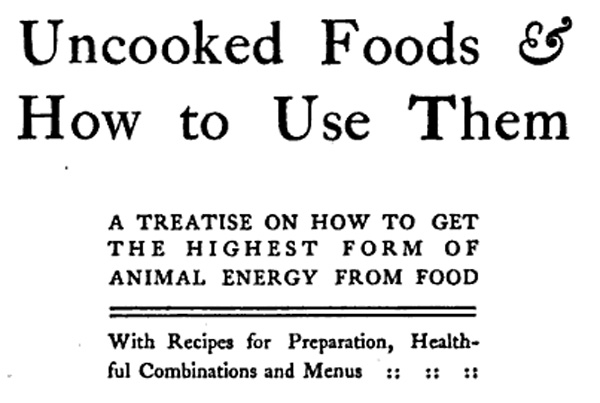Now and then, I like to immerse myself in the diet of another time and culture. I’ve been hungry, vegetarian, kosher, vegan, and drunk.
Recently, my friend Sharon (of Starting from Scratch) emailed me a 1904 cookbook: Uncooked Foods and How to Use Them, by Eugene and Molly Griswold Christian. It’s an early raw- foods manifesto and you can read it on Google Books here. For the next week, my diet will be entirely “raw.”
What is a Raw Diet?
A contemporary raw diet is defined by “unprocessed raw vegan foods that have not been heated above 115 degrees Fahrenheit (46 degrees Celsius). ‘Raw foodists’ believe that foods cooked above this temperature have lost their enzymes and thus a significant amount of their nutritional value and are harmful to the body, whereas uncooked foods provide living enzymes and proper nutrition. ” (source) There are several liberal offshoots of the raw food movement, wherein you include a certain percentage of raw foods in your diet, or simply always not cook foods that can be eaten raw, and cook foods that cannot.
Eugene and Molly Christian are both less specific, and more strict in their diet: it contains no heated foods, and although they do have a chapter on warm soup, the recommend against it. There are additional prohibitions on vinegar, “fermented” foods (like alcohol), and leavened bread. Their diet, however, is not vegan: raw seafood and meat are acceptable.
The raw food diet is the most primordial diet a person can eat: before man discovered fire, his diet was entirely raw. Modern histories of the raw food movement begin with this ideal of early man, mention Pythagoras (who was vegetarian) and then skip straight to the 1930s, when a raw food clinic opened up in Switzerland. There is no mention of the Christians and Uncooked Foods, despite the fact that this seems to be the earliest raw food “cook” book there is.
Why Go Raw?
According to Uncooked Foods, there are three reasons:
1. Simplicity and Economy. Less ingredients and less time spent cooking equals more money and time for other things.
2. As a Remedy. The Christians were “cured” of all their ailments by a raw food diet, which is what inspired them to write their book. They say that most ailments are caused by a poor diet and eating nature’s perfect foods, uncooked, is the remedy.
3. Emancipation of Women. The Christians argue that less time spent cooking equals more time for women to do other things. Preparing three meals a day is incredibly labor intensive; I’ve done it for the purposes of this blog. As soon as I finished one meal it was time to get ready to make the next. Freedom from these duties will “…Prove and important factor in lifting [women] mentally, morally and physically into an entirely different sphere.” An intriguing idea–and not something I had envisioned as part of this early manifesto.
Uncooked Foods says that “raw” is a horrible, ugly word for this movement. A ripe apple or peach is not “raw,” the authors argue: “These things are finished, ready for use; they are perfect, they are not raw, they are done; and when they are cooked, they are undone.”
The Menu for this Week
I’ll be posting about my experiences daily.


Pingback: Diets: Going Historically Raw « Four Pounds Flour - raw-food
This looks interesting, good luck! It seems that the Christians didn’t get as exploratory as the raw movement seems to be now. Are you going into this full force and using all un-pasteurized dairy products as well?
No raw milk for me! I’ll be talking more about that in my next post.
The menu looks pretty good- lots of yummy food here. Where were the Christians from? I am wondering at the expense and availability of the fruits and vegetables in winter. (though the dries fruits help with that a lot!)
Will you post the “egg nog” recipe, which I assume has no alcohol? Is it sweetened?
The book was published in New York, so I’d bet that where they were from. Lots of access to the best produce there; and I do think this menu was designed for the winter/early spring. It shows that a raw diet can be followed even when there aren’t many fresh vegetables available.
Eggnog recipe is below; but keep in mind, alcohol kills Salmonella bacteria. Consume this at your own risk.
FAMILY EGG NOG Two eggs stiffly beaten stirred into one quart of rich milk A little grated nutmeg or a spoonful of fruit juice and whipped cream added to the egg nog will improve the taste very materially.
The menu looks pretty good- lots of yummy food here. Where were the Christians from? I am wondering at the expense and availability of the fruits and vegetables in winter. (though the dried fruits help with that a lot!)
Will you post the “egg nog” recipe, which I assume has no alcohol? Is it sweetened?
Pingback: Raw Food | Testing Five
Great post. I’m a big advocate for eating mostly raw food. I think that everyone is different, and what works for someone might not work for others, but that doesn’t mean I don’t think some “diets” are better than others. To me, eating mostly raw foods isn’t even a diet. It’s more of a lifestyle. It changed many different aspects of my life and I know others can experience the same benefits. I have my own raw food review blog at http://www.rawfoodland.com. Please check it out.
It’s definitely a lifestyle–a “diet” is a word that means what we eat; the weight loss connotation is a modern definition.